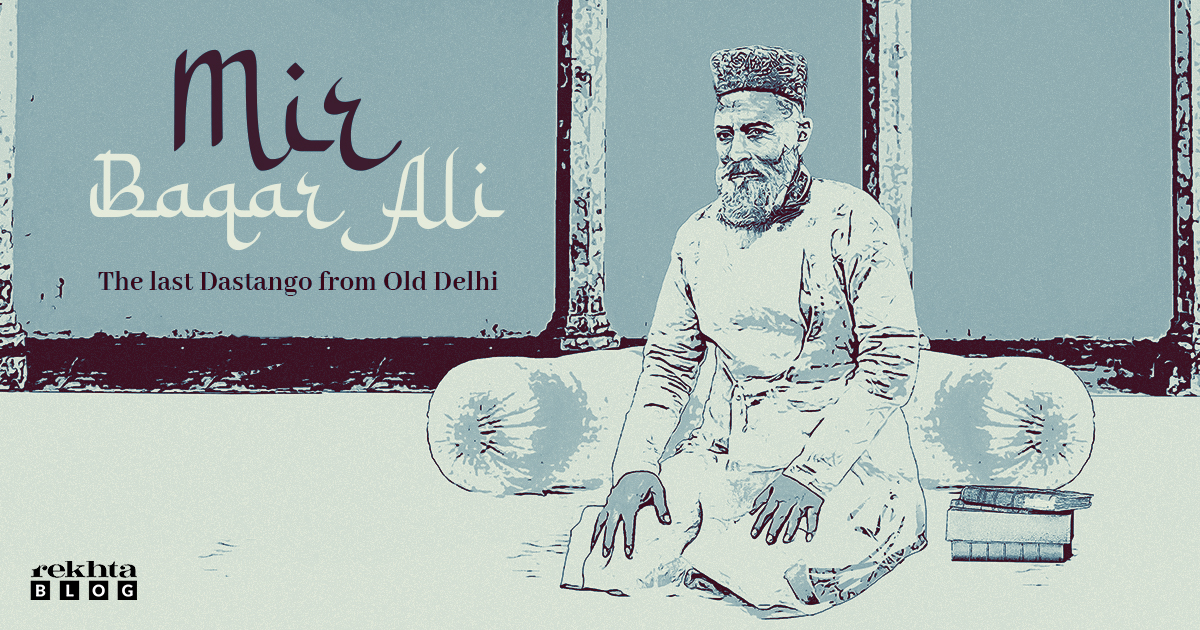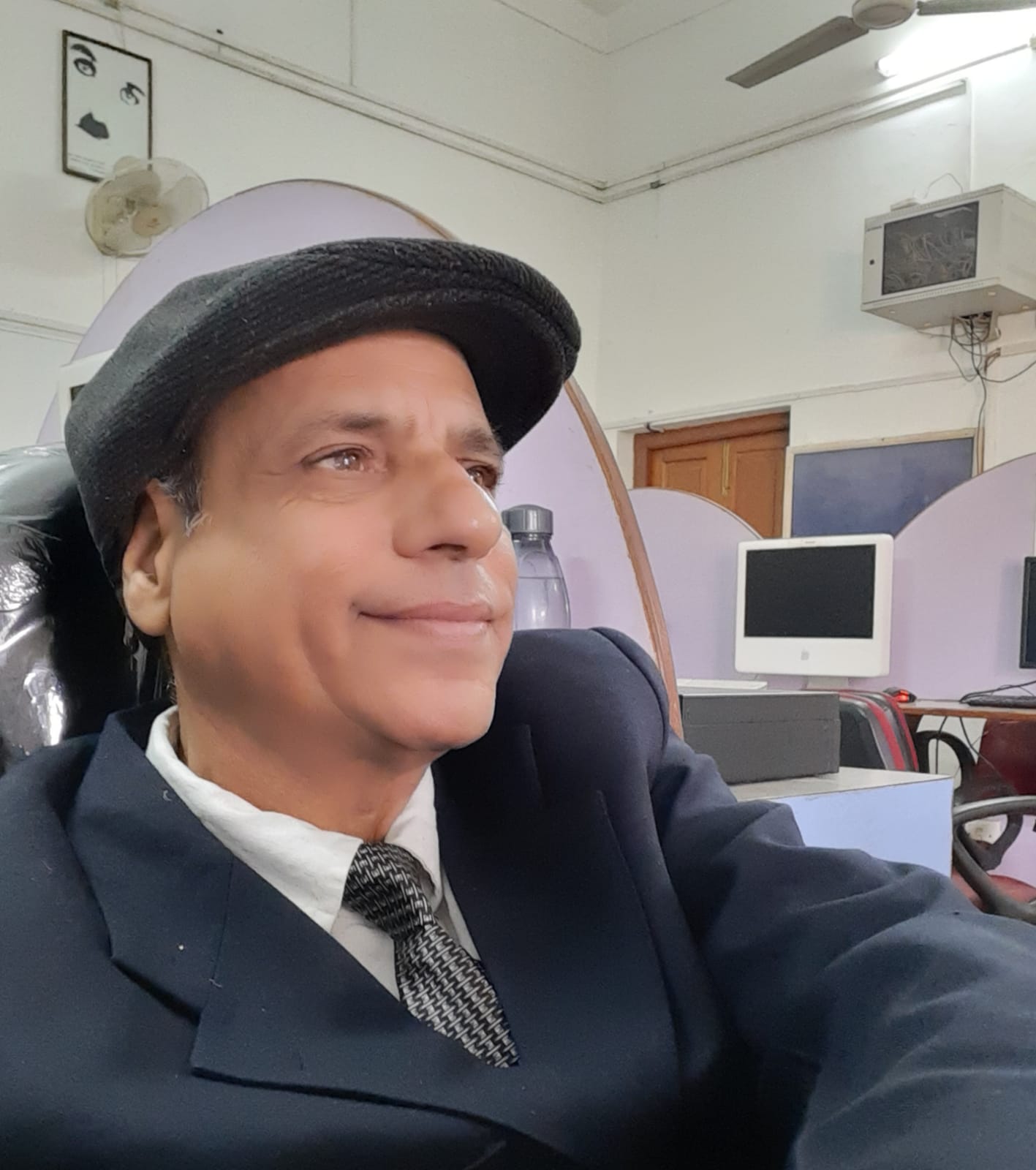
Meer Baqar Ali, the last Dastango from Old Delhi
Today, we present a portrait from the ‘Auraq-e-Musawwar’, the sepia-toned artist’s sketchbook – Meer Baqar Ali, the last Daastaango (storyteller) from Old Delhi whose life delineates the outline of the poignant transition from oral tradition to cinema and electronic media.
Born in 1851, Meer Baqar was frail with a wheatish complexion, medium height, and a white goatee. He wore a Dupalli (two-sided) cap, an Angarkha, tight pyjamas and a Desi red leather Jutti. He was armed with a rare gift of the gab and eclectic knowledge.
Meer Baqar was patronised by an Old Delhi aristocrat, Chhunna Mal, and according to their family, a single story lasted for about 25 years and still with no end in sight! Meer Baqar used to tell his version of the story of ‘Tilism-e-Hoshruba’, published by Nawal Kishore Press in forty-six volumes.
Someone asked him once: “Meer Sahab, have you ever finished this story?”
“Only once in my lifetime”, he replied.
Meer Baqar’s ancestors were royal storytellers in the Mughal Court. It was said about one of them, probably Meer Ameer, his maternal grandfather and mentor, that once there was just one screen between the lover and the beloved, and the pair could unite at the drop of a screen still, only if Meer-ji would let it. He continued to dwell on the fine sentiments of lovers, the details of dresses, jewellery and delicate romantic feelings for twelve long years! The curiosity of the King got the better of him, and he ordered: “Today the curtain must go up”, and then, at last, the lovers-in-mid-air-pause united. Elders in old Delhi who had heard his grandfather say that Meer Sahab was no match for his ‘Ustaad’. Perhaps Meer Ameer did not let the curtain arise for 12 years, whereas Meer Baqar would do so in just two years!
Just imagine – an evening of Meer Sahab’s storytelling: spotless white sheets, a wooden Takht, a carpet and a round, longish pillow. The audience would sit propped against the round pillows with ‘Paan’ and ‘Huqqa’ doing the rounds.
Meer Baqar would discretely pinch some opium from a silver casket, wrap it in cotton and stir in a small silver cup. When ‘Chunia Begum’ (a fond, loving urf or alias for opium, perhaps coined by Meer Baqar) fully dissolved in the water, he would sip away while the audience fantasised like children, mesmerised and gawking, glued to the storyline.
Meer Baqar would use variations in tone and inflexion and act out sequences too cumbersome for words to make it easy for the rapt listeners.
Meer Baqar was a voracious reader, and his passion for learning was lifelong. His motley knowledge of Philosophy, Maths, Literature, Psychology, Logic and Astronomy made his stories more credible because of what Henry James called ‘solid specification’.
Meer Baqar wrote some booklets about the society of those days. In ‘Ahl-e-Mohalla,’ he dwells on the Company Raj. The town crier would shout, “Created by God, country of the king, command of the Queen;” but even in those days public was happy and had enough leisure to learn physical exercises, namely Banot, Phakdhi, Belia, Naag Modh, Baah Todh, Baketi, Baan.k, Pata, Latheti, Bal Dandh, Mugdar, Naal etc.
However, nobody asked for Meer Baqar after the advent of cinema, and he was impoverished in his senior years; he would sometimes tell a story for just an anna and sold betel nuts to make both ends meet.
In the foreword of ‘Kaana Baati’, Salim-ur-Rehman, writes: “Meer Baqar Ali inherited the art of storytelling, and he got immense popularity as a Daastaango. A few booklets, stories and some articles in literary journals are part of his memorabilia. Even these were published in his last 15-20 years with hardly any patrons and listeners left.”
According to Shahid Ahmad Dehlvi, “Meer Sahab did not narrate published stories, but from his imagination. However, the characters of his stories were mostly drawn from Tilism-e-Hosh-Ruba. There was no Munshi Nawal Kishore who would have commissioned him to write stories and preserved them by publishing. If nothing else, he could have been asked to compile a dictionary of ancient arts and sciences, occupations and rituals and customs.”
According to Shahid Ahmad Dehlvi, “Meer Sahab was an ocean of knowledge of various arts and sciences, and his knowledge was not bookish. He would enumerate hundreds of names when he came to weapons and arms. The same was true of his knowledge of the names of jewels and dresses. The most amazing fact is that he did not know these names by rote, but if someone interrupted to ask about any name, Meer Sahab would describe in detail.”
Some samples remain of Meer Baqar Ali’s writings and have become extremely rare. Here is a list of some of his prominent writings:
1-Khalil Khan Fakhta
2-Bahadur Shah Ka Maula Bux Haathi
3-Gaadhay Khan Ka Dukhra
4-Gaadhay Khan Ne Malmal Jaan Ko Talaaq Di
5-Baaton Ki Baatein
6-Kaam ki Baatein
7-Ahl-e-Mohalla aur na-ahl parosi
8-Ustaani
9-Aadab-o-Akhlaq
10-Aaqa Naukar
11-Ara Ra Ra Dhoon
12-Chori Seena-zori
13-Kaun
14-Khaatma-e-Dastaan
The most compelling description of Meer Baqar can be read in Ashraf Suboohi’s sketch:
“His grandfather Meer Ameer Ali was a royal Qissago in the Red Fort. His uncle Meer Kazim Ali competed with the storytellers of Wajid Ali Shah and always won. The fame of his Hazaar Dastan reached Hyderabad during the reign of Sir Aasman Jaah Bahadur. He was invited there and was valued and appreciated so much that he stayed put. Meer Baqar Ali was his disciple. The relationship of uncle and nephew, and intending to continue the tradition of the art of storytelling, Meer Kazim Ali trained him with love and, in turn, learnt too. Meer Kazim Ali left a student like Baqar Ali, but Meer Baqar Ali left no one to continue his name when he passed away in 1928.
zamāna baḌe shauq se sun rahā thā
hamīñ so ga.e dāstāñ kahte kahte
‘Meer Baqar Ali, Dastango, Dastanein Aur Dastan-Goi’ is an important book compiled by Aqeel Abbas Jafri, published by Anjuman Taraqqi Urdu Pakistan in 2014.
The book has a foreword by Ziya Mohiuddin and sketches by Ashraf Suboohi, Mulla Wahidi, Shahid Ahmed Dehlvi, Syed Yusuf Bukhari Dehlvi, Feroze Dehlvi, Mohammad Salim-ur-Rehman, Aziz Hamid Madni, and a poem about Meer Sahab by Zaif Syed.
The book contains the text of stories by Meer Baqar Ali, namely Bahadur Shah Badshah ka Maula Bakhsh Haathi, Baaton ki Baatein, Sarai ka Naqsha, Faqeer ka Takiya, Sarai ka Naqsha and a selection entitled Kaana Baati.
Good to know that some efforts are being made to revive this vanishing oral tradition of India.
Someone’s soul is smiling from up above,
Hope shines on the horizon.
NEWSLETTER
Enter your email address to follow this blog and receive notification of new posts.




